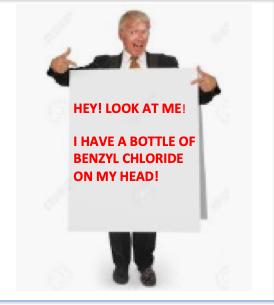Two Arkansas chemistry professors are either: a) a couple of morons, or b) extremely unlucky.
There is just not enough information in the news to tell which of the above is true. The coverage is all over the place. For example:
- The Economic Times of India said "One of the arrested ‘speed’ profs had, in a university magazine interview earlier, said how much he enjoyed 'Breaking Bad'. This seems like rather scant evidence to me. If I'm a fan of The Three Stooges does this mean I'm automatically a suspect every time someone goes on an eye-poking spree?
- WREG, the CBS affiliate in Arkansas, reported that "three days [before the two men were arrested], police investigated a report of a chemical odor in the campus science center." If that's all the evidence the police have then they should turn these guys loose ASAP. If a stinky lab was a crime every chemist in the galaxy would be doing time. Have you ever walked into one of them? Disgusting. And, even worse, inevitably there is some jackass in the building splashing around something so vile that roaches have been observed booking out of the building at cheetah-like speeds.
- CNN tells us that "[A university spokesperson] would not elaborate on what was found following the report of a chemical odor, nor would she confirm whether the professors were suspected of making meth inside the school." But also that "[the two men] face charges of manufacturing methamphetamine and using drug paraphernalia." How odd. There's a stinky chemical in the chemistry building, two guys get arrested for making meth, but they made it elsewhere? Doesn't make much sense.
- We finally get some information from the New York Times, but it's not all that convincing.
- There was a report of undetermined chemical odor and testing revealed an elevated presence of benzyl chloride in a lab.
- The EPA weighs in and tells us that "benzyl chloride is used to produce certain dyes and pharmaceutical products." Huh? That's a bit like saying that the letters "B" and "W" make up the entire alphabet. Benzyl chloride, a very common reagent, can be found in most organic chemistry labs in the world and it's used for all kinds of reactions to make an enormous variety of organic compounds. Including drugs and dyes. But chemists hate using it because...
- (More from the EPA) "Short-term effects from inhaling it include irritation of the skin, eyes and upper respiratory tract." Well, that's a bit of an understatement. Go ahead and take a good snootful of the stuff. You will feel like an irate mule kicked you and your face out of the window of the 85th floor of the Empire Statement Building and you landed nose first in a simmering vat of CaJohns Get Bitten Black Mamba Six – reportedly the hottest sauce in the world.

Subtle marketing at its finest. Photo: Fox News
But now we finally have some information and it bespeaks poorly of the chemical acumen of Bradley Allen Rowland and Terry David Bateman, the two men who were charged with meth making. Because if you're trying to hide a chemical benzyl chloride is a really bad choice. It has a sweet, cloying and choking odor that is unmistakable. It would be difficult to come up with a worse chemical to try to hide. Why not just do this?

Time for a little meth chemistry. No need to call the DEA. I've written about it before. And it's hardly as if this information is a state secret. There's a website that gives you 20 different procedures to make meth from a wide variety of chemicals. One of the chemicals that is found repeatedly on the site is called benzyl cyanide aka, phenylacetonitrile.
If the cops found benzyl cyanide in the lab then that might be a serious cause for suspicion. Likewise, if they found a bottle of sodium cyanide sitting around with the benzyl chloride because the following reaction is a piece of cake:

So, the presence of either benzyl chloride plus sodium cyanide, or of benzyl cyanide makes things a bit more interesting. This is because another common reagent, methylmagnesium chloride, reacts with it to form phenyl-2-propanone, aka P2P or phenylacetone.

If any P2P was found then things will not end well for Rowland and Bateman. Because there is pretty much only one reason that phenylacetone exists – to make meth. And it's very easy. Its called the P2P method.

The P2P method was what Walter White switched to because it is far easier to make meth this way than by synthesizing it from a bazillion Sudafed pills – now a controlled drug that is behind the counter. And in true government fashion, this backfired. Once the geniuses at the DEA decided to designate Sudafed as a controlled substance the P2P method was also adapted by meth cookers in Columbia. The net result: more and purer meth hit the streets and people with allergies had to provide ID to buy it. Typical US drug policy.
So, is there enough evidence to put Rowland and Bateman in the slammer for a long time? The chemistry will tell.




